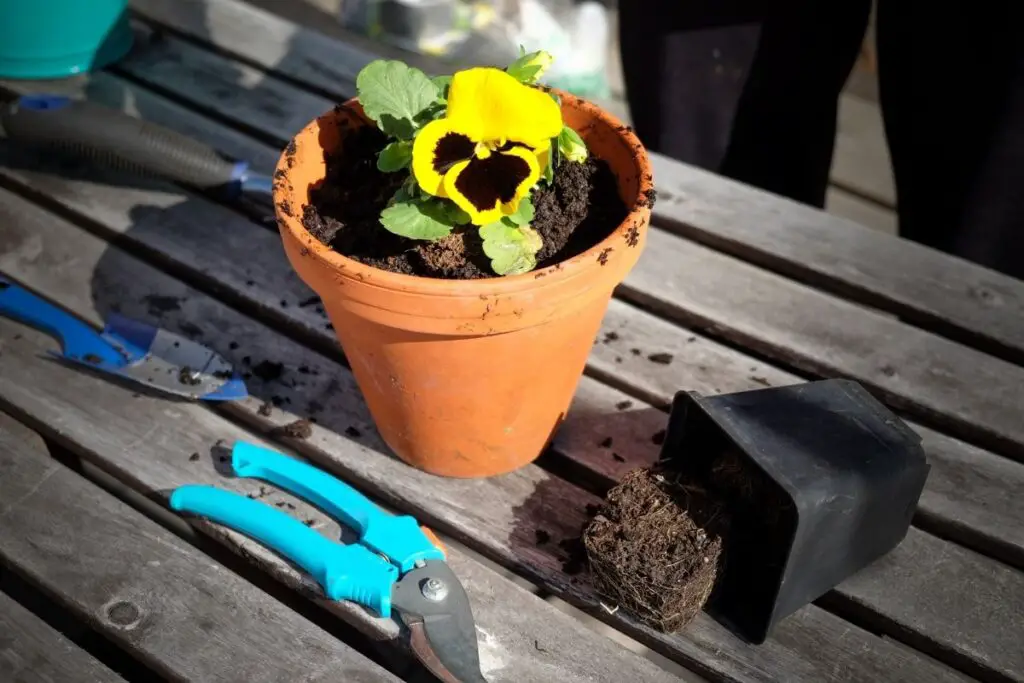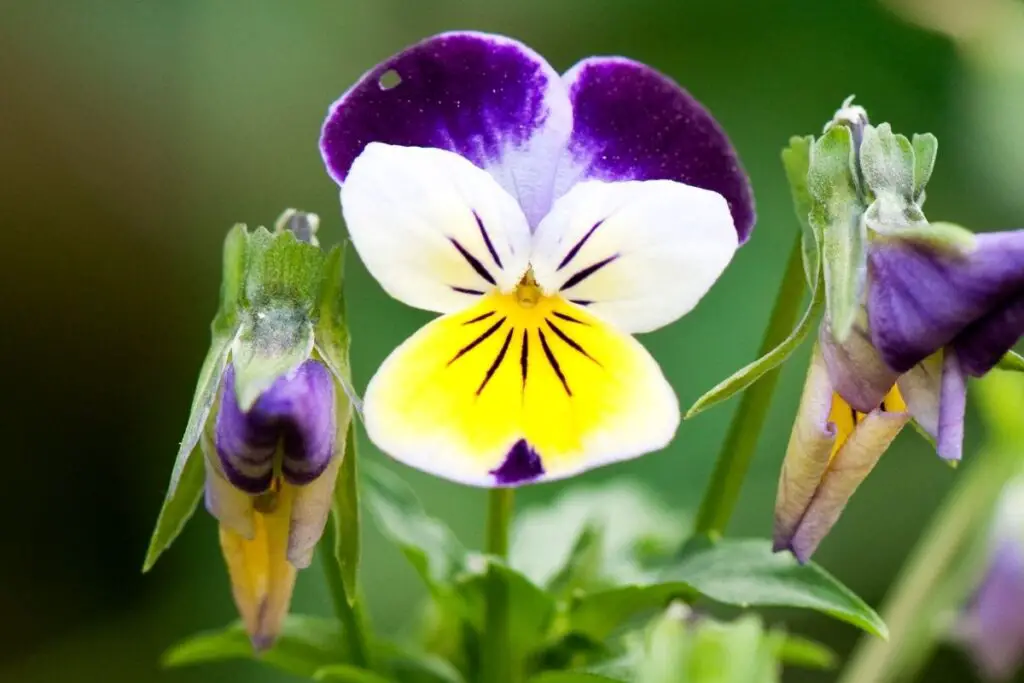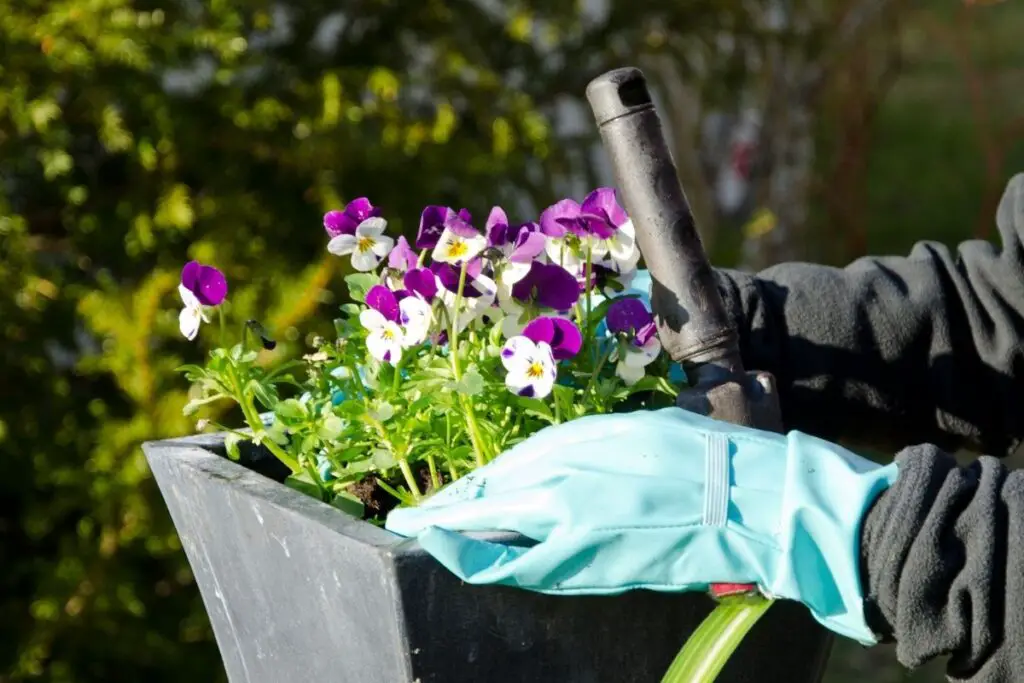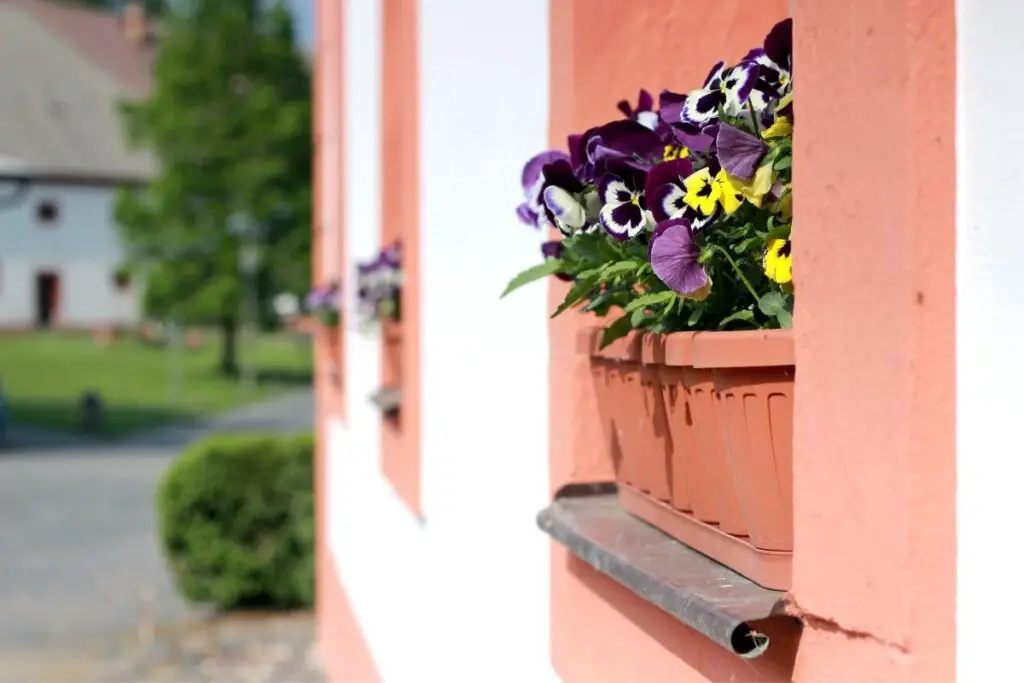Pansies bloom best in full sun and prefer moist, slightly acidic soil with good drainage. But sometimes despite providing them with the best care, our pansies don’t bloom much.
So, in this article, we shall learn how to make our pansies bloom more.
To encourage blooming in pansies, you can take certain steps like:
- Fertilize the plant every 2-3 weeks with balanced liquid fertilizer
- Add phosphorus-rich fertilizer like bonemeal just before the blooming season.
- Prune any leggy growth in the plant
- Deadhead existing blooms to encourage more blooms.
Different species of pansies have different flowering seasons in different regions.
The blooming in pansies depends on many factors such as temperature, light, water, nutrients, and soil. A change in any of these elements can cause stress in pansies that affect their blooming process.
It will also discuss the reasons behind poor blooming and describe the steps to help your plants rebloom.

Pansies flowering season
You can plant pansies in the early spring or fall months. But if you want to grow pansies from seeds, you can sow them in late winter for early spring and summer flowering.
You can also start seeds in late summer for fall for winter flowering.
Pansies have poor heat tolerance capacity that is why they start producing seeds instead of blooming in summers.
There are some varieties of pansies like springtime, Maxim, and dynamite that bloom well in summer.
Causes that prevents blooming in pansies
Pansies are easy-to-grow plants. You can make your pansies bloom by taking care of their basic requirements. But sometimes, they may still not bloom.
There are some reasons which don’t let them bloom. They are as follows:
- Poor sunlight
- The difference in varieties
- Lack of pruning
- Inappropriate amount of nitrogen
- Overcrowding pansies
- Plantation at the wrong time
Let us discuss each point in detail.
Poor sunlight
Pansies love the sun and need at least 6 hours of full sun. They may not bloom because of poor sunlight. If pansies are planted in a shadier spot, then they may not have any flowers.
There can be so many obstacles that may block the path of sunlight. For example, a house or any structure may block the sunlight during the day.
Also, natural factors like rainy weather and cloudy days obstruct sunlight, and pansies don’t get the sun they need. If this continues for a stretch, your pansies will become stressed.
So, the first thing pansies will do is start dropping their flowers and buds and put all their resources to stay alive.
Also read: How Much Sun Do Pansies Need? (Pansies Light Requirements)
The difference in pansy varieties
There are different varieties of pansies, and some varieties bloom later in the season. Their sowing period is also different.
A poor understanding of their difference in varieties and their requirements can be the reason for no blooms on your plants.
Lack of pruning
Lack of pruning will develop seed pots when the blooms fade.
If pansies start developing seeds and are in their reproductive stage, it is an indication that they will bloom slower.
So for pansies to bloom well, deadheading is essential. If you don’t remove the spent flowers, then pansies will utilize all their energy to produce seeds instead of flowers.
Inappropriate amount of nitrogen
Nitrogen plays a vital role in growing pansies. It encourages the growth of leaves and plant tissues.
It is an essential food for soil organisms that converts nutrients into forms that are available to plants.
But adding too much nitrogen will harm them. Too much nitrogen lead to an explosion of foliage growth at the cost of flower formation and root growth.
Also read: Do Pansies Need Fertilizer? (What Type, How Much & More)
Overcrowding pansies
Overcrowding pansies will not allow them to bloom well. Overcrowded pansies suffer from poor air circulation, which increases the chances of fungal diseases.
Since many plants are close to each other, they will not get an even distribution of sunlight, so the pansy plants will try to make themselves stretch more towards the sun.
For this, they will attempt to grow longer stems over blooming, making them weak and leggy.
Looking for gardening supplies? We have tested 100's of products before recommending them to you guys. Check out our best pick below:
| Image | Gardening Supplies | Best Price? |
|---|---|---|
 Top
Top Top
Top | Raised Garden Bed Kit | Check On Amazon |
 | XLUX Soil Moisture Meter, Plant Water Monitor, Soil Hygrometer Sensor for Gardening, Farming, Indoor and Outdoor Plants, No Batteries Required | No Results |
 Top
Top Top
Top | 82 Pcs Garden Tools Set and Extra Succulent Tools Set | Check On Amazon |
 | Joeys Garden Expandable Garden Hose with 8 Function Hose Nozzle, Lightweight Anti-Kink Flexible Garden Hoses, Extra Strength Fabric with Double Latex Core, (50 FT, Black) | No Results |
 Top
Top Top
Top | Dual Chamber Compost Tumbler | Check On Amazon |
 Top
Top Top
Top | Sunnyglade Plant Stakes | Check On Amazon |
 Top
Top Top
Top | Organic Cold Pressed Neem Seed Oil | Check On Amazon |
 Top
Top Top
Top | Mighty Mint Gallon :-Insect and Pest Control Peppermint Oil | Check On Amazon |
 Top
Top Top
Top | Scotts DiseaseEx Lawn Fungicide | Check On Amazon |
 Top
Top Top
Top | Jacks Classic 20-20-20 All Purpose Fertilizer | Check On Amazon |
 Top
Top Top
Top | 30,000 Seeds Pollinator Attracting Wildflower Mixture | Check On Amazon |
 Top
Top Top
Top | Survival Vegetable Seeds Garden Kit-Over 16,000 Seeds | Check On Amazon |
Plantation at the wrong time
If the pansies are planted at the wrong time for your zone, this perhaps is why pansies do not bloom. The temperature is either too hot or too cold for them.
Pansies are pretty resilient. They may not grow when you want them to, but they will indeed produce flowers when the weather warms or cools as needed.
Also read: Do Pansies Bloom The First Year? (Pansies Blooming Guide)
How can you make your pansies bloom again?

Pansies are generally the first plants to come up in spring. They will continue to bloom until the temperature rise and cause the plants to become dormant. There are a few methods to make your pansies bloom again.
These are:
Understand why pansies tend to stop blooming
First, you need to identify the reasons due to which your pansies are not blooming. You have to consider the factors that are stopping them from blooming.
You have to check the soil, sunlight, nutrition, temperature, and watering techniques. An analysis of these elements is vital to understanding your plant.
Pinch off seed pots to help pansies bloom again
Pansy seeds will grow in long fall climates and will remain dormant until the following spring.
You need to remove the seeds pot before the seed gets fully developed. You can do this by removing the spent flowers, cutting their extra growth and stems.
Remove dead blooms regularly
You have to check your pansy plants regularly for any blooms that had died.
You have to remove these dead flowers from pansies to encourage them to use their energy toward new blooms and growth. Remove damaged portions of the plant, too, while removing dead blooms.
Keep the soil moist and apply phosphorus fertilizers
Pansies prefer rich loam soil that retains the required moisture, so keep the soil moist by adding enough water but avoid overwatering.
Apply phosphorus fertilizers to the soil. Avoid fertilizers that are rich in nitrogen, as pansies can’t handle high levels of nitrogen.
Cutaway growth and leggy stems
You should remove the leggy stems of your pansies because these will not produce any blooms.
If you don’t prune them, the pansies will keep using their energy to grow these stems. This will cause them to produce fewer stems.
Shift your pansies to a new location
You have to consider the location of your plant. The place should be a cool, sunny, moist, disease-free, and protected garden area.
Shift your potted pansies to a location with enough sunlight, like a windowsill or terrace of your house.
Pansies look rough and do not care when placed in an area that allows large amounts of rain or wind. You have to prepare a protective shield or cover for protecting them under such conditions.
Protect them against pests and insects
Pansies are hardy plants, but they are highly vulnerable to pests and insects like critters, bugs, snails, aphids, scales, and caterpillars.
These insects will eat their leaves and flowers and hinder their blooming process. Try to keep your plant away from these pests by using neem oil, horticulture oil, sprays, etc.
Plant new pansies if your existing ones begin to die
If your pansies stop producing blooms and begin to die back, then you have to replant the old plant with a new pansy plant.
You have to understand that your pansies can’t bloom anymore, and it’s time for the new plants to arrive.
How do you get more blooms from pansies?

Pansies are easy to grow, and they will flower longer and produce more abundantly with a small amount of care and effort.
Some care tips will help your pansies to bloom more. They are as follows:
- Adequate amount of watering
- Using a rich soil
- Fertilization
- The appropriate amount of sunlight
- Organic mulching
- Removal of unwanted items
- Deadhead blooms
- Separation of non-productive sections of pansies
- Shearing pansies
- Protection against pests and diseases
Let us now discuss each point in detail.
Adequate amount of watering
Pansies always prefer fertile and moist soil. Adding the correct amount of water is essential for their blooming. Water them regularly to prevent the planting site from drying out.
The pansy plants grow best when the soil is moist, but they never like wet or soggy soil. To prevent fungal diseases, avoid watering the foliage.
Pansies can stop blooming and will produce seeds if they are allowed to dry out.
Also read: How Much Water Does A Pansy Need? (Pansy Water Requirements)
Using a rich soil
Pansies prefer rich loamy soil with lots of drainage capacity. You can use loamy soil rich in organic matter like aged compost or mushroom compost.
Well-rotted manure provides lots of nutrition to pansies. It helps in encouraging bacterial activity, which promotes soil fertility.
You can provide compost to the soil while planting them and keep adding them from time to time.
Also read: What Type Of Soil Is Best For Growing Pansies? (+Best Soil Mix)
Fertilization
You can feed your pansies with a water-soluble fertilizer. This will increase their blooming rate.
You can use liquid fertilizers such as Miracle-Gro all-purpose plant food 15-30-15. Always follow the packaging instructions carefully.
An appropriate amount of sunlight

Light is essential for pansies growth. Direct sunlight for several hours is an essential factor for flowering plants like pansies. Minimum 6 to 7 hours of direct sunlight is good for pansies.
They never prefer excess heat, and you have to make arrangements for partial shade during such conditions.
Too much heat will make the pansies stop producing flowers. Always grow your pansies in a location that provides adequate sunlight.
Organic mulching
Organic mulching is beneficial for blooms. You can spread an organic layer of 2-inches made up of organic mulch such as bark, leaves, grass clippings, or pebbles over the planting area.
This retains the moisture of the soil. It does not let the soil dry quickly and discourages the weeds that compete with desirable plants for water, light, and nutrients.
Removal of unwanted items
You should remove the unwanted stems of pansies. You can cut the stems off just above the first set of leaves with clean, sharp garden shears.
You can pull them with your hand, just don’t pull too hard, or you may damage the healthy parts of plants. The more you pick them, the more they will flower.
Deadhead pansies
Deadhead pansies continuously since the pansies will refuse to bloom as they begin seeding.
You can pinch off the spent blooms as they fade. This will give them space for further blooming and will extend the blooming season. Trim out seed heads as they appear.
Separation of non-productive sections of pansies
You should remove some of the stem growth if an area of the plant does not seem to be blooming.
There are non-productive sections of plants like stems and foliage, which deprive the prolifically blooming plants of light and nutrients.
Shearing pansies
You should shear the pansy plants back to about 3 inches when they stop blooming as the weather changes and heats up.
This helps the plants fill out and resume flowering when the temperatures drop at the end of the season.
Protection against pests
The most common pests of flowering pansies are caterpillars, snails, slugs, aphids, mealybugs, and thrips. These pests hide under the leaves and the growing tip of plants where the tissues are soft.
They eat the healthy portions of the plant and don’t allow them to bloom. You have to be alert with them, especially with snails, one of the pests that ravenously devour pansies.
You can handpick them and drop them in a bucket of soapy water.
You can dig a small hole in the garden and bury a disposable plastic container within ¼ inch of its rim in the soil to create a snail trap.
Pick these drowned snails out of the brew the following morning. Wash the whole plant several times in 2 or 3 weeks. Apply an approved pesticide.
Also read: How To Get Rid Of Pests On Pansies? (Bugs Identification+Solution)
Final words
Don’t go too hard on your pansies. Let them grow at their own pace and enjoy their natural growth without expecting them to bloom all the time.
Instead, try to do everything you can to make sure that the pansies are growing in a healthy and suitable environment. Healthy pansies will bloom more naturally.
Ref: The University of Arkansas, Britannica, Utah State University, Wikipedia, The University of Georgia, The Pennsylvania State University, The Royal Horticultural Society.
